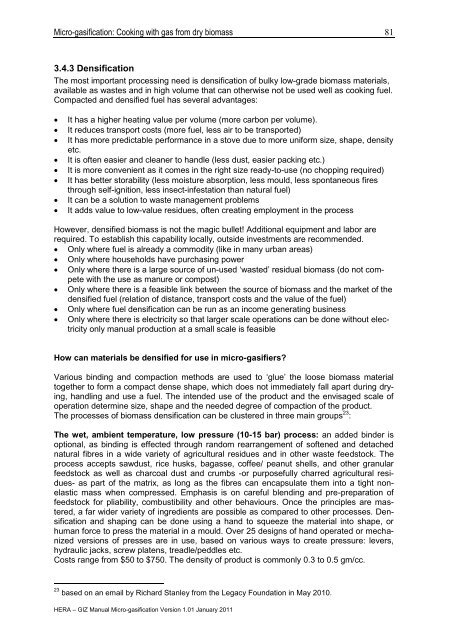Micro-gasification: Cooking with gas from biomass - Amper
Micro-gasification: Cooking with gas from biomass - Amper
Micro-gasification: Cooking with gas from biomass - Amper
Create successful ePaper yourself
Turn your PDF publications into a flip-book with our unique Google optimized e-Paper software.
<strong>Micro</strong>-<strong><strong>gas</strong>ification</strong>: <strong>Cooking</strong> <strong>with</strong> <strong>gas</strong> <strong>from</strong> dry <strong>biomass</strong><br />
3.4.3 Densification<br />
The most important processing need is densification of bulky low-grade <strong>biomass</strong> materials,<br />
available as wastes and in high volume that can otherwise not be used well as cooking fuel.<br />
Compacted and densified fuel has several advantages:<br />
It has a higher heating value per volume (more carbon per volume).<br />
It reduces transport costs (more fuel, less air to be transported)<br />
It has more predictable performance in a stove due to more uniform size, shape, density<br />
etc.<br />
It is often easier and cleaner to handle (less dust, easier packing etc.)<br />
It is more convenient as it comes in the right size ready-to-use (no chopping required)<br />
It has better storability (less moisture absorption, less mould, less spontaneous fires<br />
through self-ignition, less insect-infestation than natural fuel)<br />
It can be a solution to waste management problems<br />
It adds value to low-value residues, often creating employment in the process<br />
However, densified <strong>biomass</strong> is not the magic bullet! Additional equipment and labor are<br />
required. To establish this capability locally, outside investments are recommended.<br />
Only where fuel is already a commodity (like in many urban areas)<br />
Only where households have purchasing power<br />
Only where there is a large source of un-used ‗wasted‘ residual <strong>biomass</strong> (do not compete<br />
<strong>with</strong> the use as manure or compost)<br />
Only where there is a feasible link between the source of <strong>biomass</strong> and the market of the<br />
densified fuel (relation of distance, transport costs and the value of the fuel)<br />
Only where fuel densification can be run as an income generating business<br />
Only where there is electricity so that larger scale operations can be done <strong>with</strong>out electricity<br />
only manual production at a small scale is feasible<br />
How can materials be densified for use in micro-<strong>gas</strong>ifiers?<br />
Various binding and compaction methods are used to ‗glue‘ the loose <strong>biomass</strong> material<br />
together to form a compact dense shape, which does not immediately fall apart during drying,<br />
handling and use a fuel. The intended use of the product and the envisaged scale of<br />
operation determine size, shape and the needed degree of compaction of the product.<br />
The processes of <strong>biomass</strong> densification can be clustered in three main groups 23 :<br />
The wet, ambient temperature, low pressure (10-15 bar) process: an added binder is<br />
optional, as binding is effected through random rearrangement of softened and detached<br />
natural fibres in a wide variety of agricultural residues and in other waste feedstock. The<br />
process accepts sawdust, rice husks, ba<strong>gas</strong>se, coffee/ peanut shells, and other granular<br />
feedstock as well as charcoal dust and crumbs -or purposefully charred agricultural residues-<br />
as part of the matrix, as long as the fibres can encapsulate them into a tight nonelastic<br />
mass when compressed. Emphasis is on careful blending and pre-preparation of<br />
feedstock for pliability, combustibility and other behaviours. Once the principles are mastered,<br />
a far wider variety of ingredients are possible as compared to other processes. Densification<br />
and shaping can be done using a hand to squeeze the material into shape, or<br />
human force to press the material in a mould. Over 25 designs of hand operated or mechanized<br />
versions of presses are in use, based on various ways to create pressure: levers,<br />
hydraulic jacks, screw platens, treadle/peddles etc.<br />
Costs range <strong>from</strong> $50 to $750. The density of product is commonly 0.3 to 0.5 gm/cc.<br />
23 based on an email by Richard Stanley <strong>from</strong> the Legacy Foundation in May 2010.<br />
HERA – GIZ Manual <strong>Micro</strong>-<strong><strong>gas</strong>ification</strong> Version 1.01 January 2011<br />
81
















